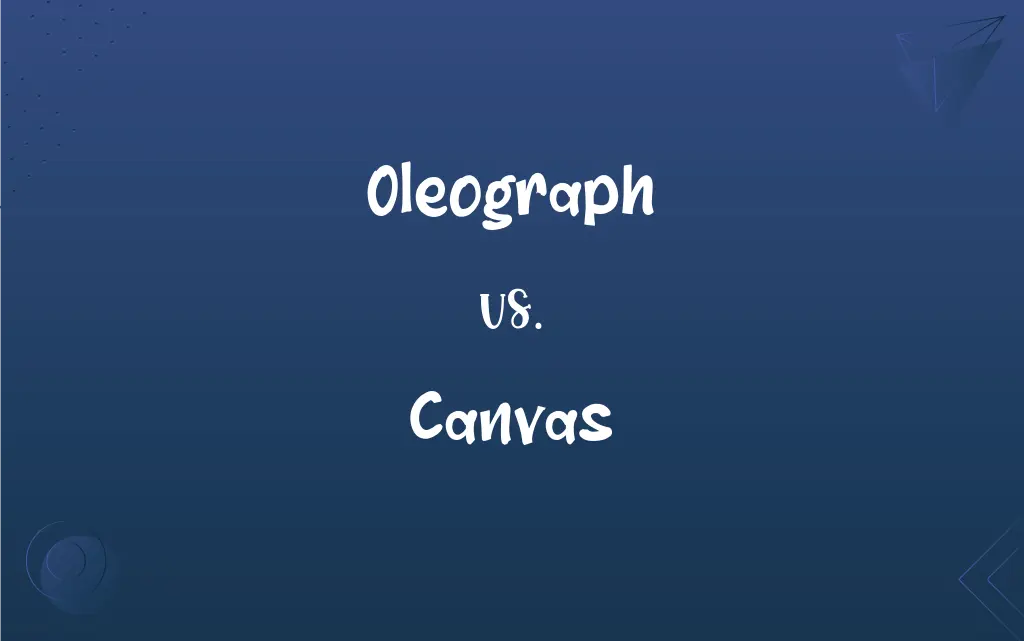Oleograph vs. Canvas: What's the Difference?
Edited by Aimie Carlson || By Harlon Moss || Updated on November 8, 2023
An oleograph is a printed reproduction of a painting using oil colors, while canvas is a strong fabric used as a surface for painting.

Key Differences
An oleograph is a type of lithograph that is printed with oil paints to mimic the look of an oil painting, offering an affordable alternative to owning a genuine painting. Canvas, on the other hand, refers to a heavy-duty fabric made from cotton, linen, or synthetic materials, commonly used by artists as a support for painting.
Oleographs were popular in the 19th century, allowing middle-class people to decorate their homes with replicas of fine art. Canvases have been used for centuries by artists and remain a primary support for oil and acrylic painting, prized for their durability and the way they absorb paint.
The production of an oleograph involves a process that can create a textured surface resembling that of a painted canvas. A blank canvas serves as a literal blank slate for artists, who apply layers of paint to create original works of art or sometimes prints or reproductions.
While oleographs are generally mass-produced items, canvases can be part of both the creation of original artwork and the production of prints or reproductions. Each oleograph is the end product of its creation process, whereas a canvas can be reused or painted over if the artist desires.
Collectors might seek oleographs as decorative pieces or affordable alternatives to originals, while canvases often hold the allure of originality and the unique touch of the artist's hand. Canvases are also a key supply in art studios, art classes, and among hobbyists who appreciate the material's versatility.
ADVERTISEMENT
Comparison Chart
Definition
Printed artwork using oil paints.
Heavy-duty fabric for painting.
Usage
Reproduction of paintings.
Original artwork and reproductions.
Production
Mass-produced.
Individually prepared for painting.
Appearance
Simulates the texture of a painting.
Offers texture and absorbs paint.
Collectability
Decorative and affordable art option.
Original art and high-quality reproductions.
ADVERTISEMENT
Oleograph and Canvas Definitions
Oleograph
Affordable art reproduction.
He collected oleographs when he couldn't afford real paintings.
Canvas
Support for oil or acrylic paint.
His vibrant use of colors brought the canvas to life.
Oleograph
Oil-paint based printing.
The texture of this oleograph feels surprisingly like real brush strokes.
Canvas
Base material for artistic works.
The blank canvas stood ready for the first stroke of paint.
Oleograph
Mass-produced colored lithograph.
Victorian homes often featured oleographs as art decor.
Canvas
Durable fabric for artists.
She stretched a new canvas on the frame for her next piece.
Oleograph
19th-century art innovation.
Oleographs brought fine art to the burgeoning middle class.
Canvas
Used for making sails, tents, and marquees.
The strong canvas was ideal for the outdoor market stalls.
Oleograph
Printed image resembling an oil painting.
The oleograph on the wall mimicked a famous Van Gogh.
Canvas
Metaphorical for a foundation or background.
The scandal served as a canvas for the political drama.
Oleograph
A chromolithograph printed with oil paint on canvas in imitation of an oil painting.
Canvas
A heavy, coarse, closely woven fabric of cotton, hemp, or flax, traditionally used for tents and sails.
Oleograph
(arts) A type of chromolithograph, using oil paint on canvas, that attempts to imitate oil painting
Canvas
A piece of such fabric on which a painting, especially an oil painting, is executed.
Oleograph
The form or figure assumed by a drop of oil when placed upon water or some other liquid with which it does not mix.
Canvas
A painting executed on such fabric.
Oleograph
A picture produced in oils by a process analogous to that of lithographic printing.
FAQs
Are oleographs valuable?
Oleographs can have decorative value but are typically less valuable than original paintings.
Is canvas only for painting?
No, canvas is also used for sails, tents, and other items needing durable fabric.
What is an oleograph?
An oleograph is a printed picture that imitates an oil painting.
How do I preserve an oleograph?
Keep it out of direct sunlight and frame it under UV-protective glass.
How do I stretch a canvas?
Stretch a canvas by pulling it over a frame and securing it with staples or tacks.
What is canvas?
Canvas is a sturdy fabric used by artists as a surface for painting.
Do oleographs feel like original paintings?
High-quality oleographs can mimic the texture, but the feel may differ from an original.
Can I paint on an oleograph?
Oleographs are not designed for painting; they are finished prints.
Can you print on canvas?
Yes, canvas can be used for printing, often for high-quality art reproductions.
Were oleographs considered art?
Oleographs were a popular form of decorative art in the 19th century.
What's the best way to clean a canvas painting?
Dust it with a soft, dry brush; consult a professional for deeper cleaning.
Are oleographs collectible?
Yes, they can be collectible, particularly if they are rare or have historical significance.
Can oleographs be on canvas?
Yes, oleographs can be printed on canvas to mimic the texture of paintings.
How long does an oleograph last?
With proper care, oleographs can last many years without significant fading.
Are all canvases made of cotton?
No, canvases can also be made of linen, jute, or synthetic materials.
How do I choose a canvas?
Consider the type of paint you're using and the texture you desire.
Can oleographs fade over time?
Yes, like all prints, oleographs can fade, especially if exposed to sunlight.
Is there a difference in quality among oleographs?
Yes, the quality can vary based on the printing process and the materials used.
Can I create my own canvas?
Yes, you can create a canvas by stretching canvas fabric over a wooden frame.
Can canvas size affect my painting?
Yes, the size of the canvas can impact the scale and detail of your artwork.
About Author
Written by
Harlon MossHarlon is a seasoned quality moderator and accomplished content writer for Difference Wiki. An alumnus of the prestigious University of California, he earned his degree in Computer Science. Leveraging his academic background, Harlon brings a meticulous and informed perspective to his work, ensuring content accuracy and excellence.
Edited by
Aimie CarlsonAimie Carlson, holding a master's degree in English literature, is a fervent English language enthusiast. She lends her writing talents to Difference Wiki, a prominent website that specializes in comparisons, offering readers insightful analyses that both captivate and inform.
































































